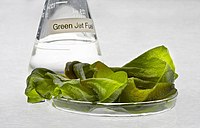
Photo from wikipedia
In order to reduce the consumption of traditional fossil fuels and their impact on the environment, strategies to mitigate greenhouse gas emissions especially carbon dioxide needs exploration. Microalgae-based biofuels can… Click to show full abstract
In order to reduce the consumption of traditional fossil fuels and their impact on the environment, strategies to mitigate greenhouse gas emissions especially carbon dioxide needs exploration. Microalgae-based biofuels can be the best-fit plant based feed-stocks for diminishing a majority of the Universe’s energy problems. Interestingly, the eukaryotic microalgae aid in fixation of almost 50% of the global carbon in the environment. Thus, determination of parameters that will enhance microalgal growth and productivity is crucial, if they are to be used as future renewable energy sources. A large percentage of phytoplankton species are auxotroph for one or more vitamins. These species, in turn, are also dependent upon the vitamin biosynthetic pathways for processing of these vitamins. The present study serves as a base to discuss the prevalence of vitamin auxotrophy in microalgae and the methods of its acquirement from external sources such as heterotrophic bacteria. The next section of the paper sheds light on possible species-specific symbiotic interactions among microalgae and bacteria. Lastly is the discussion on how heterotrophic bacteria can act as a vitamin prototroph for an explicit microalgal vitamin auxotroph. The overall focus is placed upon harnessing these symbiotic interactions with intentions to obtain enhancements in microalgal biomass, lipid productivity, and flocculation rates. Moreover, the growth and distribution of a microalgal cell that thrives on a specific vitamin is perhaps met by growing it with the bacterial communities that nourish it. Thus, possibly by ecologically engineering a potential species-specific microalgal–bacterial consortium, it could tremendously contribute to the acceleration of photosynthetic activity, microalgal productivity, exchange of primary metabolites and other biogeochemical nutrients within the mini ecosystem.
Journal Title: Microbial Cell Factories
Year Published: 2017
Link to full text (if available)
Share on Social Media: Sign Up to like & get
recommendations!